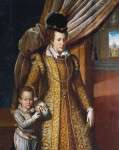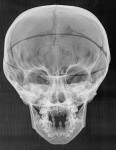Although the deficiency of vitamin D that causes rickets is often linked to the malnutrition and polluted, tight, sunless living environments of the urban poor, a recent study has found that scions of the wealthy Medici family, Grand Dukes of Tuscany, suffered from rickets.
 In 2003, researchers at the University of Pisa and University of Florence began the exhumation of 49 Medici burials in the the Basilica of San Lorenzo in Florence. They began with the crypt of Grand Duke Gian Gastone, the last Medici Grand Duke of Tuscany and brother of Anna Maria, Electress Palatine. They removed a marble disk in the floor that they thought was just decorative only to find a stone staircase leading to a secret crypt. Inside this small space was a large sarcophagus on a low platform and a number of small wooden coffins which had been damaged by the great flood of 1966. The small sarcophagi had collapsed to the floor or been scattered by the waters onto the platform. The crypt was plagued with dry mold, 90% humidity and temperatures in the upper 80s, so on the advice of Florence’s famous art conservation institute the Opificio delle Pietre Dure, researchers built a special climate-control chamber to counteract the inimical environment and to keep out external air which might accelerate decay.
In 2003, researchers at the University of Pisa and University of Florence began the exhumation of 49 Medici burials in the the Basilica of San Lorenzo in Florence. They began with the crypt of Grand Duke Gian Gastone, the last Medici Grand Duke of Tuscany and brother of Anna Maria, Electress Palatine. They removed a marble disk in the floor that they thought was just decorative only to find a stone staircase leading to a secret crypt. Inside this small space was a large sarcophagus on a low platform and a number of small wooden coffins which had been damaged by the great flood of 1966. The small sarcophagi had collapsed to the floor or been scattered by the waters onto the platform. The crypt was plagued with dry mold, 90% humidity and temperatures in the upper 80s, so on the advice of Florence’s famous art conservation institute the Opificio delle Pietre Dure, researchers built a special climate-control chamber to counteract the inimical environment and to keep out external air which might accelerate decay.
The small coffins held the remains of nine Medici children who died between zero and five years of age. Despite the hot, wet and moldy environment, several of the burials were remarkably well-preserved. One five-year-old’s funerary clothes were still intact: a red silk and silver jacket in a floral pattern, shoes, a silver crown. A one-year-old’s silk vest with silver cuffs also survived, although not in so good a condition.
 X-ray and osteological analysis of the child remains found that six of the nine showed the distinctive signs of rickets — curved arm and leg bones — even in very early infancy. That means that these children of great privilege, raised in the lap of Renaissance luxury, not only suffered from vitamin D deficiency as they were growing up, but were afflicted by it practically at birth.
X-ray and osteological analysis of the child remains found that six of the nine showed the distinctive signs of rickets — curved arm and leg bones — even in very early infancy. That means that these children of great privilege, raised in the lap of Renaissance luxury, not only suffered from vitamin D deficiency as they were growing up, but were afflicted by it practically at birth.
Rickets is easily prevented by eating foods such as eggs and cheese and by spending short amounts of time exposed to sunlight, which triggers vitamin D production. To understand why the Medici children had this avoidable illness, the researchers analysed the nitrogen isotopes found in bone collagen, which reflect the main source of protein in the diet. They found that most of the children were not weaned until age 2, in keeping with Renaissance custom. Historical texts suggest that at that time, breast milk was supplemented with ‘paps’ made of soft bread and apples. Neither cereals nor breast milk contain much vitamin D, and fruit contains none.
Sixteenth-century thinking also dictated that infants be heavily swaddled. The Medici children, wrapped in many heavy layers and cocooned in large, grand houses, probably didn’t get the same amount of sunlight as their less fortunate peers.
Even two Medici newborns showed signs of rickets, although they should have received all the vitamin D they needed before birth from their mothers. The researchers argue that the mothers themselves might have had a low-level vitamin D deficiency because of the heavy makeup worn by high-status women, or as a result of their frequent childbearing. Medici wife Eleanor of Toledo, for example, bore 11 children in 14 years.
The skeletal remains of Eleonora of Toledo were also exhumed. The wife of Cosimo I, Eleonora’s bones revealed relatively good muscular development so she wasn’t a listless shut-in or anything, but she too had rickets during her childhood. Both of her tibias are curved. She died at 40 from pulmonary tuberculosis and malaria.
 Researchers were able to identify the boy in the red jacket as Filippo de’ Medici, the only son and heir of Grand Duke Francesco I and his wife Joanna of Austria, who died in 1582 just two months shy of his fifth birthday. Don Filippino suffered from non-severe hydrocephalus, probably caused by a traumatic birth, and the characteristic curved tibia and fibula of rickets. The hydrocephalus was noted by the physicians who performed an autopsy on him in 1582. When they removed the cranial vault, they found “underneath the first membrane of the brain, almost a glass of water.” The sharp, clean line from the horizontal craniotomy is still clearly visible on the skull and X-rays.
Researchers were able to identify the boy in the red jacket as Filippo de’ Medici, the only son and heir of Grand Duke Francesco I and his wife Joanna of Austria, who died in 1582 just two months shy of his fifth birthday. Don Filippino suffered from non-severe hydrocephalus, probably caused by a traumatic birth, and the characteristic curved tibia and fibula of rickets. The hydrocephalus was noted by the physicians who performed an autopsy on him in 1582. When they removed the cranial vault, they found “underneath the first membrane of the brain, almost a glass of water.” The sharp, clean line from the horizontal craniotomy is still clearly visible on the skull and X-rays.
 His mother Joanna was not a well woman. Her bones show limited muscular development, so she was not a physically active woman. And no wonder: she had a congenital dislocation of the hip and scoliosis so severe that her in addition to a curved lumbar column she also had a pronounced deformity of the pelvis. She gave birth eight times despite this. Of her eight children, only two girls survived to adulthood. One of them was Marie de’ Medici, Queen of France. The eighth delivery, a stillborn son who came out arm-first, ruptured her uterus and killed her. Joanna of Austria was 30 years old when she died.
His mother Joanna was not a well woman. Her bones show limited muscular development, so she was not a physically active woman. And no wonder: she had a congenital dislocation of the hip and scoliosis so severe that her in addition to a curved lumbar column she also had a pronounced deformity of the pelvis. She gave birth eight times despite this. Of her eight children, only two girls survived to adulthood. One of them was Marie de’ Medici, Queen of France. The eighth delivery, a stillborn son who came out arm-first, ruptured her uterus and killed her. Joanna of Austria was 30 years old when she died.
You can see why this fragile woman and her sickly child might not have gotten out much. They were both ill for all of their short lives. Poor kids, whatever the nutritional deficiencies they had to cope with, at least got to run around outside enough to absorb vitamin D from the sun.
Is the scan of the damask-wrapped boot, oddly labelled “Filippino burial clothes” perhaps the prosthetic boot from the coffin of Francesco I? http://www.karger.com/Article/Fulltext/338667
In the small coffin of don Filippino, a part the dress and the crown, there was any “prosthetic boot” of Francesco I (buried in a separate tomb), but only the small shoes of the child.
medical history is a subset of history I really, really enjoy.
This whole Rickets thing may be one factor in why, all over Europe, and not just Italy, for centuries you sometimes hear about Aristocratic families with a lower child survival rate than their subjects, and no clear cause listed for the deaths of the little ones. It could also be the cause for many still-births also. I do know that Rickets affects pregnancy, maybe if mom has it, maybe all she can do is pop out still-borns, or kids who would not last long, especially if lack of vitamin D is not improved after birth. Little peasant kids at least get their 15 minutes a day (the minimum needed I believe), or more of sunshine when mom and dad take them to gather turnips for supper (or whatever) while uppity “Master Johns” heir gets to stay inside having fun and developing Rickets if he wasn’t born with it. Just a thought.
Fascinating. I really enjoy the detective work involved in figuring out the reason’s why someone or somthing turns out the way they do…especially when that something pertains to a great historical family such as this. The more true details you know about them, the more you feel you come to know them in a way.
:chicken: :angry:
I do find it interesting to learn about past lives and how their daily routines were affected by illnesses that would be so easily cured, today. It was much the same for my family during the Great Depression. Out of 11 children, 5 died, in part, dur their poverty and lack of access to medical treatment. Although, the research is fascinating, at the same time I do not like that 49….or any deceased people are dug up and disturbed. Again, I am between…wow, Ricketts and Vitamin D might have changed and extended lives…….ok, they had Ricketts.
yeah i feel exactly the same as Pat it’s not that interesting about a person having rickets
I do not find it interesting to learn about past lives and how their daily routines were affected by illnesses that would be so easily cured, today. It was much the same for my family during the Great Depression. Out of 11 children, 5 died, in part, dur their poverty and lack of access to medical treatment. Although, the research is fascinating, at the same time I do not like that 49….or any deceased people are dug up and disturbed. Again, I am between…wow, Ricketts and Vitamin D might have changed and extended lives…….ok, they had Ricketts.